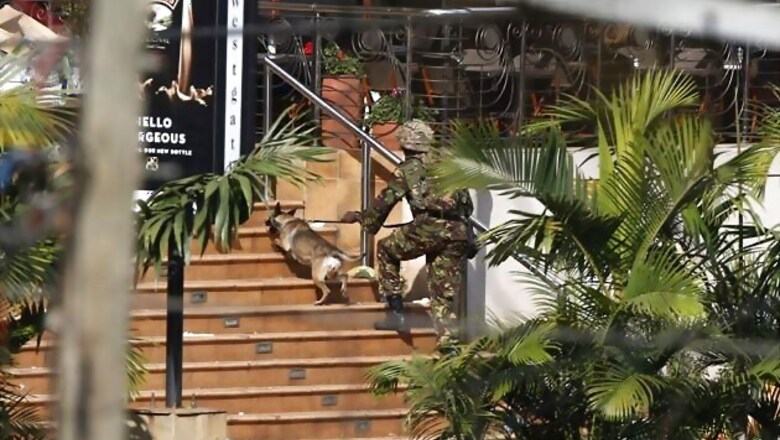
views
Nairobi: Salim Massebellah had just reached the parking lot at Nairobi's premiere mall. Private guards inspected his trunk, then passed a mirror underneath his vehicle, checking for the exposed wires that would indicate a bomb. That was the weapon of choice of al-Shabab, the terrorist group Kenyans had been warned might one day target their capital.
Moments later, the shooting erupted. The terrified guards ran, dropping the mirror. It hit the pavement with a clang.
Sitting stiffly at the wheel, Massebellah saw the two attackers pass by his car. Each one was holding a single, belt-fed machine gun. What neither of them was wearing was a suicide vest. "They were shooting indiscriminately," said Massebellah. "There was nothing the guards could have done."
Experts say the attackers' choice of weapons, including AK-47s and grenades, was decidedly low-tech for al-Shabab, the al Qaeda affiliate based in neighboring Somalia which is known for their lethal use of suicide bombers. And it's this very decision to use small arms, instead of explosives, that made possible the most deadly terrorist attack in Kenya since the 1998 bombing of the United States embassy, analysts say.
If copied elsewhere, including in Western countries, this style of attack could prove equally difficult to stop, both because public places like malls cannot be protected in the same manner as government buildings, and because security services are trained to detect explosives, not small arms.
"My assessment has always been that the day that al-Shabab lets go of the 'Cult of the Suicide Bomber,' we will be in world of trouble," said Matt Bryden, the former coordinator of the United Nations Monitoring Group on Somalia and Eritrea. "It's far more complicated to procure the parts for an explosive vest, as well as to find people willing to be martyrs. I always worried that if you just get guys riding in with AK-47s and grenades, they could do incredible damage," he said. "We have now reached that dangerous place."
CCTV footage retrieved from Westgate Mall shows only four attackers took part in the prolonged siege, though others may have been a part of the Sept. 21 attack and fled, according to a government official close to the investigation who insisted on anonymity because he was not authorized to speak on the matter. This handful of fighters easily overpowered the mall's unarmed security guards, killing over 60 civilians and leaving the mall awash in blood. It would be hours before Kenya's notoriously dysfunctional military arrived on the scene in force, leaving petrified shoppers to fend for themselves.
At the front entrance of the mall, 37-year-old Mamtaz Jamal ran a promotional table selling creams. That morning she had carefully laid out one of her tubs of milk-and-honey scrub, putting a decorative halo of pebbles around the circular pot. She heard an earsplitting bang, and looked up to see the glass walls of a nearby jewelry shop shattering.
The attackers had lobbed a grenade inside. She ran, looking back just long enough to see that one of the attackers had grabbed a Caucasian man. He was holding him by the back of the neck, forcing him to walk in front, like a human shield. "With his other hand he was shooting," said Jamal.
It was as if the fighter was expecting to be met with return fire. But the first men to return fire, including off-duty cops and members of a neighborhood watch group, were using pistols to fight hardened terrorists with automatic weapons.
"Perhaps the most alarming thing about the operation is that it was low-tech," says Richard Downie, the deputy director of the Africa program at the Center for Strategic and International Studies. "Clearly someone has realized that you don't need to assemble bombs and suicide vests. All you need is some light arms and grenades, then you choose a soft target - and off you go," says Downie, who testified before Congress this week on al-Shabab's evolving tactics.
Former FBI agent Don Borelli, who investigated al-Shabab's 2010 attack in Uganda, said that even in the United States, law enforcement would struggle to contain an attack of this nature. "To be quite honest, we are not protected. The average mall in the US does not involve walking through metal detectors. It's a very soft target. The security there wouldn't be any match for a group of people with assault weapons. Even a police officer is not designed to stand up to military weapons ... So in terms of vulnerability, we are very vulnerable."
Al-Shabab, meaning "The Youth" in Arabic, carried out its first suicide attack in Somalia in 2006. By 2008, the group was dispatching multiple bombers to different locations who carried out simultaneous attacks. While their tactics were deadly in their homeland, their reliance on explosives made it difficult for them to export terror beyond Somalia's borders, said Bryden, now the executive director of Sahan, a Kenya-based think tank.
One major exception was an al-Shabab bomb attack during the screening of the 2010 World Cup final in Uganda's capital in July 2010. More than 70 people were killed. Since then, the group has tried on multiple occasions to smuggle explosives into Kenya.
"These plans have without exception been detected, or disrupted. What it suggested is that moving explosives and components for bombs has proven too difficult," says Bryden.
It's also much easier to recruit attackers, if the plan does not involve dying. Bryden, who has spent two decades researching Somalia, says that in the past, al-Shabab has struggled to find Kenyans willing to partake in suicide missions. The fact that the fighters at Westgate were speaking Swahili to each other, the national language of Kenya, suggests that they succeeded. It's not yet known if the attackers managed to escape after the attack.
Hints of a change in tactics could be seen earlier this year in Mogadishu. In April, al-Shabab attacked the country's Supreme Court, using a suicide bombing to breach the perimeter before unleashing gunmen inside. In June, they attacked a U.N. compound, using explosives to blow up the main gate. Gunmen rushed inside, slaughtering around a dozen people.
"Suicide bombings have been the centerpiece of every major, spectacular al-Shabab attack over the last seven years. And it's only in 2013 that we have seen attacks in which suicide bombers have become accessories to the main assault, which is carried out by gunmen," says Bryden. "Suicide bombers are no longer the center of gravity of al-Shabab tactics - and that is the shift that has enabled the attack to take place here in Nairobi."
As of Saturday, the death toll stood at 67 people killed. Massebellah survived by sitting like a statue, his car stopped in front of the drop arm, as people were slaughtered around him in the parking lot. Nearby, a man was killed at the wheel of his car. His 13-year-old daughter survived by playing dead next to her father's corpse.
Jamal survived by hiding inside a women's clothing shop, huddling in the back with other frightened shoppers. Alongside her was her colleague, who had been hit by shrapnel in the leg. When it became clear that no one was coming for them, she found a pair of scissors inside the store and used it to cut off his jeans.
She took a scarf off of the rack to tourniquet his bleeding leg.



















Comments
0 comment